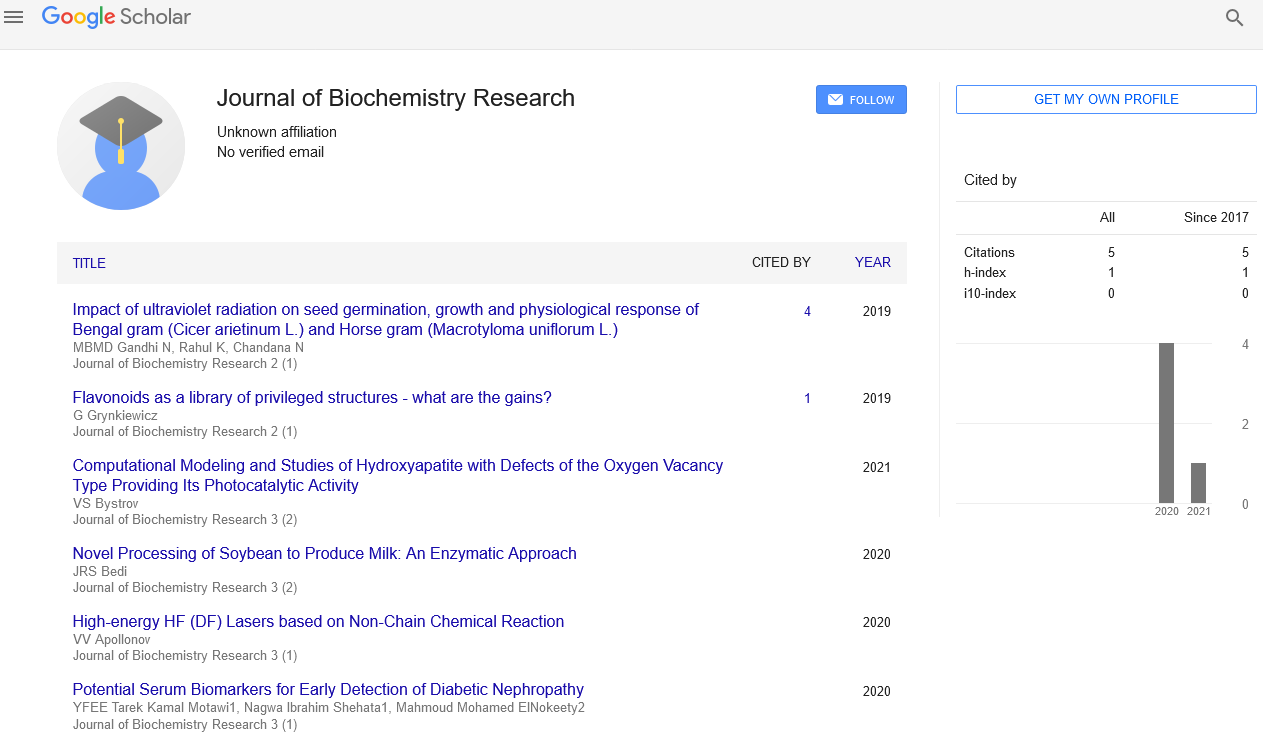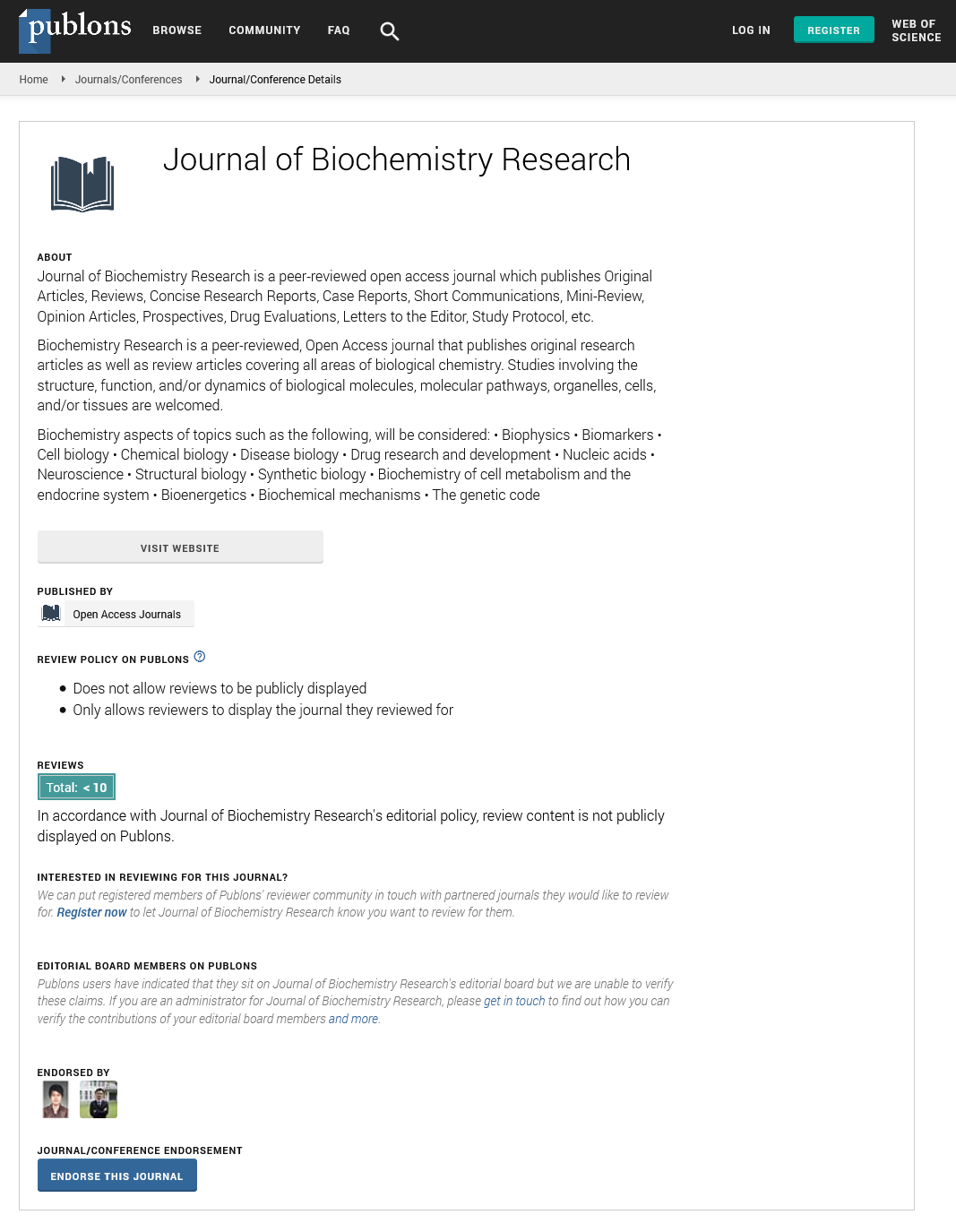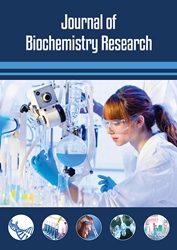Mini Review - Journal of Biochemistry Research (2023) Volume 6, Issue 2
Protein synthesis and Transcription and Translation
Dr. Abhaya Raj*
Department of Biochemistry, Genetic and Protein Codes, University of AKTU, India
Department of Biochemistry, Genetic and Protein Codes, University of AKTU, India
E-mail: abhaya.r@gmail.com
Received: 03-April-2023, Manuscript No. oabr-23-96577; Editor assigned: 05-April-2023, PreQC No. oabr-23- 96577; Reviewed: 19-April-2023, QC No. oabr-23-96577; Revised: 22-April-2023, Manuscript No. oabr-23-96577 (R); Published: 29-April-2023; DOI: 10.37532/ oabr.2023.6(2).20-22
Abstract
Protein synthesis is the complex biological process by which cells builds proteins, the fundamental building blocks of life. This process is essential for the growth, maintenance, and repair of living organisms, and involves a precise sequence of events that must occur in a specific order. The process of protein synthesis begins with the transcription of DNA, the genetic material that stores the instructions for making proteins, into messenger RNA (mRNA). This process takes place in the nucleus of the cell, where an enzyme called RNA polymerase reads the DNA sequence and synthesizes a complementary mRNA strand. The mRNA molecule then travels from the nucleus to the cytoplasm of the cell, where it encounters ribosomes, the cellular structures responsible for translating the genetic code into proteins. Ribosomes consist of two subunits, each made up of RNA and protein molecules. The process of translation begins with the binding of the mRNA molecule to the small ribosomal subunit. The ribosome then scans the mRNA molecule until it encounters a start codon, which signals the beginning of the protein-coding sequence. Next, transfer RNA (tRNA) molecules, which are specific to each amino acid, carry the amino acids to the ribosome. Each tRNA molecule contains an anticodon, which matches the codon on the mRNA, as well as a binding site for the corresponding amino acid. As the ribosome moves along the mRNA molecule, it brings the appropriate tRNA molecule into position so that the anticodon on the tRNA cans base-pair with the codon on the mRNA. The ribosome then catalyzes the formation of a peptide bond between the amino acids carried by the adjacent tRNA molecules.
Keywords
Protein synthesis • Complex biological • Cells builds proteins • Messenger RNA (mRNA) • Transfer RNA (tRNA) molecules, and protein-coding sequence
Introduction
Protein synthesis is a fundamental biological process that occurs in all living organisms. Proteins are essential macromolecules that perform a wide range of functions, including enzymatic reactions, structural support, transportation of molecules, and cell signalling [1]. The process of protein synthesis involves the translation of genetic information encoded in DNA into a specific sequence of amino acids, which are the building blocks of proteins. This process is carried out by ribosomes, which are large molecular complexes that read the information stored in messenger RNA (mRNA) and use it to assemble the corresponding sequence of amino acids. Understanding the molecular mechanisms of protein synthesis is critical for understanding the basic principles of biology and the underlying causes of many genetic diseases. In this introduction, we will explore the key steps of protein synthesis, the roles of different cellular components involved in this process, and the implications of protein synthesis for cellular function and human health [2].
This process continues until the ribosome encounters a stop codon, which signals the end of the protein-coding sequence. The newly synthesized protein is then released from the ribosome and folds into its final three-dimensional structure, which determines its function in the cell. Protein synthesis is a highly regulated process that is critical for maintaining the balance of proteins within the cell [3]. Any errors or disruptions in this process can have serious consequences for the cell and the organism as a whole. Understanding the mechanisms of protein synthesis is therefore essential for advancing our knowledge of fundamental biological processes and developing new therapies for diseases caused by protein dysregulation.
Protein synthesis is the process by which cells create new proteins from amino acids [4]. Proteins are the building blocks of life, and they play a critical role in many biological processes, including cell division, DNA replication, and the immune response. The process of protein synthesis is essential for the growth, development, and maintenance of all living organisms. The process of protein synthesis can be divided into two main stages: transcription and translation. In transcription, the DNA code is used to create a messenger RNA (mRNA) molecule [5]. In translation, the mRNA is used as a template to create a protein molecule. Let’s take a closer look at each of these stages.
Transcription and Translation
Transcription is the first step in protein synthesis. It takes place in the nucleus of the cell and involves the conversion of the DNA code into an mRNA molecule. The DNA code is read by an enzyme called RNA polymerase, which creates a complementary mRNA molecule by adding nucleotides to the growing chain. The nucleotides in mRNA are complementary to those in DNA, with the exception of the nucleotide thymine, which is replaced by uracil in RNA [6].
The process of transcription can be broken down into three main steps: initiation, elongation, and termination. During initiation, the RNA polymerase binds to a specific region of the DNA called the promoter. This signals the start of transcription. In elongation, the RNA polymerase moves along the DNA strand, adding nucleotides to the growing mRNA chain. The RNA polymerase reads the DNA code in a 3’ to 5’ direction, but synthesizes the mRNA chain in a 5’ to 3’ direction. This is known as antiparallel synthesis [7]. During termination, the RNA polymerase reaches a specific sequence of nucleotides called the terminator, which signals the end of transcription. Once the mRNA molecule has been created, it leaves the nucleus and travels to the cytoplasm, where it can be used as a template for protein synthesis.
Translation is the second step in protein synthesis. It takes place in the ribosomes, which are structures in the cytoplasm of the cell [8]. During translation, the mRNA molecule is used as a template to create a protein molecule.
The process of translation can be broken down into three main steps: initiation, elongation, and termination. During initiation, the small ribosomal subunit binds to the mRNA molecule, and the initiator tRNA binds to the start codon, which is usually AUG. The start codon signals the beginning of the protein-coding sequence. In elongation, the ribosome moves along the mRNA molecule, reading the code in groups of three nucleotides called codons. Each codon codes for a specific amino acid, which is brought to the ribosome by a transfer RNA (tRNA) molecule. The tRNA molecule has an anticodon that is complementary to the codon on the mRNA molecule, and it carries the appropriate amino acid for that codon [8]. As the ribosome moves along the mRNA molecule, it links the amino acids together to form a polypeptide chain. The polypeptide chain grows until the ribosome reaches a stop codon, which signals the end of translation. At this point, the ribosome releases the polypeptide chain, which can fold into its final three-dimensional shape to form a functional protein [9].
Protein Folding and Modification
Proteins must fold into their correct threedimensional shape in order to function properly. The process of protein folding is complex and is influenced by many factors, including the sequence of amino acids, the presence of chaperone proteins, and the conditions in the surrounding environment. Once a protein has been synthesized, it may undergo further modifications to become fully functional [10]. These modifications can include the addition of phosphate.
Conclusion
Protein synthesis is a complex and intricate process that is essential to the growth, development, and maintenance of all living organisms. From the transcription of DNA to the translation of mRNA into protein, numerous cellular mechanisms work together to ensure the production of functional and efficient proteins.
The understanding of protein synthesis has come a long way since its discovery in the early 20th century. Scientists have made significant advancements in unravelling the molecular mechanisms involved in protein synthesis, such as the identification of different types of RNA molecules and the discovery of ribosomes as the site of protein synthesis. Protein synthesis plays a crucial role in many biological processes, including enzyme catalysis, cell signalling, and structural support. Defects or mutations in genes involved in protein synthesis can result in various diseases and disorders, such as cancer, cystic fibrosis, and Alzheimer’s disease. The regulation of protein synthesis is also critical for maintaining homeostasis and responding to changes in the environment. Cells can control protein synthesis through several mechanisms, including transcriptional and translational regulation, RNA processing, and protein degradation.
Furthermore, advances in genetic engineering have allowed for the manipulation of protein synthesis to produce novel proteins with unique properties for various applications in medicine, agriculture, and industry protein synthesis is a fundamental biological process that underlies many aspects of life. Its understanding has revolutionized biology and medicine and has the potential to further shape the future of science and technology.
References
- Goyal M.Endovascular thrombectomy after large vessel ischaemic stroke: a meta- analysis of individual patient data from five randomised trials. Lancet. 22, 416-430 (2016).
- Rodrigues FB.Endovascualar treatment versus medical care alone for ischemic stroke: a systemic review and meta-analysis. BMJ. 57, 749-757 (2016).
- Dwyer, Claire. ‘Highway to Heaven’: the creation of a multicultural, religious landscape in suburban Richmond, British Columbia. Soc Cult Geogr. 17, 667-693 (2016).
- Harrison, Paul. How shall I say it…? Relating the nonrelational .Environ Plan A. 39, 590-608 (2007).
- Jackson, Peter. The multiple ontologies of freshness in the UK and Portuguese agri‐food sectors. Trans Inst Br Geogr. 44, 79-93 (2019).
- Dora, Veronica Della. Infrasecular geographies: Making, unmaking and remaking sacred space. Prog Hum Geogr. 42, 44-71 (2018).
- Brunelli D, Polonelli T, Benini L. Ultra-low energy pest detection for smart agriculture. IEEE Sens J. 1-4 (2020).
- Jellish WS. General Anesthesia versus conscious sedation for the endovascular treatment of acute ischemic stroke. J Stroke Cerebrovasc Dis. 25, 338-341 (2015).
- Campbell BCV.Effect of general anesthesia on functional outcome in patients with anterior circulation ischemic stroke having endovascular thrombectomy versus standard care: a meta-analysis of individual patient’s data. Lancet Neurol. 41, 416-430 (2018).
- Lee G, Hwang J.A Novel Index to Detect Vegetation in Urban Areas Using UAV-Based Multispectral. Images Appl Sci. 11, 3472 (2021).
Indexed at, Google Scholar, Crossref
Indexed at, Google Scholar, Crossref
Indexed at, Google Scholar, Crossref
Indexed at, Google Scholar, Crossref
Indexed at, Google Scholar, Crossref
Indexed at, Google Scholar, Crossref
Indexed at, Google Scholar, Crossref


